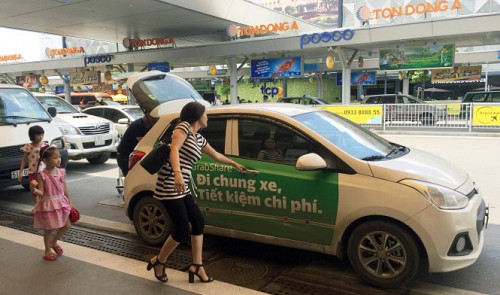Driving for Uber or Grab is not always bed of roses.
Vietnamese drivers who once eagerly jumped behind the wheel to work with Grab or Uber might have won the battle against traditional taxis, but the fight amongst themselves is just heating up.
While ride-hailing services were initially meant to help drivers with private cars earn extra cash, citizens in Vietnam’s big cities are turning to these apps as new investment paradigm, using them as an excuse to invest in buying new cars for the sole purpose of joining the ride-share networks.
Some have even turned to bank loans to purchase vehicles in the hope of reaping profits from the seemingly lucrative market.
But with the number of ride-sharing drivers soaring over such a short time, some big investors are swallowing a bitter pill.
In 2015, Bui Tan Cao, a Ho Chi Minh City resident, quit his office job to become a ride-share driver using a four-seater Kia Morning he purchased for more than VND500 million (US$22,000).
Covering nearly 60 percent of the car’s cost with bank loans, Cao is currently paying more than VND20 million ($880) in monthly interest.
An investment seemed lucrative at first, with Cao raking in up to VND15 million (S$660) a month, is now turning into a burden. The mushrooming of ride-share drivers has lowered Cao’s daily revenue to VND700,000 ($30) – VND800,000 ($35) per day, not counting fuel costs, compared to the VND1 million ($44) he was making per day when he started.
“I suffer losses for short rides through traffic,” he said.
He now drives for both Uber and Grab to “make ends meet.”
Bigger investment, bigger losses
Nguyen Phuong, who runs a transportation company in District 2, put two trailer trucks up for sale, borrowed more than VND2 billion ($88,100) from banks, and called on friends to invest in a fleet of 12 cars he planned to use in order to tap into the Uber market.
Phuong’s initial monthly profit was up to VND40 million ($1,760) but earnings began to drop by 40 percent only a few months later, he admitted.
Phuong now offers to lease his car for a mere VND400,000 – VND800,000 a day, but few drivers are interested. Eight of the heavily invested vehicles now lie dormant, while Phuong sadly acknowledges that “the Uber game is not as easy as I thought.”
Nguyen Minh Phong, a Grab driver in Tan Binh District, said tough competition between drivers of the same service is main cause of slumping earnings.
“You can find hundreds of Uber and Grab cars and taxis on just about any street,” he said.
“They also have to compete with traditional xe om [motorbike taxi], Grab Bike, and UberMoto.”
Phong said even when he sticks with his car 16 hours a day, it is still impossible to hit his previous VND1.5 million ($66) mark.
“After subtracting my costs, I only earn VND200,000 [$8] – VND300,000 [$13],” he said.
“This income is barely enough to cover daily necessities, let alone pay for the bank loan for my car.”
Grab has cut its fare for four-seater cars to only VND9,000 a km, and VND11,000 for seven-seater cars since mid-March. Though it’s great news to passengers, Phong said, “it’s a nightmare for drivers.”

























































